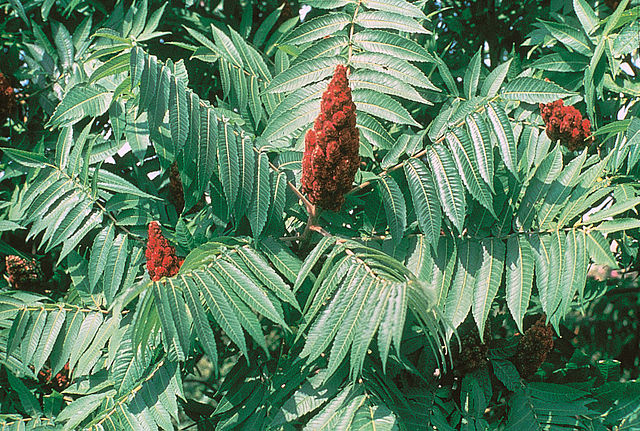- Home
- >
- Broadleaved Tree Seeds J-Z by Latin Name
- >
- Staghorn Sumac (rhus typhina)
Staghorn Sumac (rhus typhina)
SKU:
£1.10
1.1
9.75
£1.10 - £9.75
Unavailable
per item
Seed Prices
0.5 gram (approx 50 seeds) £1.10
1 gram (approx 100 seeds) £1.45
2 grams(approx 200 seeds) £1.95
5 grams (approx 500 seeds) £2.45
10 grams (approx 1000 seeds) £3.80
25 grams (approx 2500 seeds) £6.90
50 grams (approx 5000 seeds) £10.75
Use the drop down button below to select the seed quantity
Germination, Sowing and After Care Information for
Staghorn Sumac (rhus typhina)
Staghorn Sumac seeds have a natural dormancy within them, this requires a degree of patience to overcome and it is usually quite easy to get high levels of germination if the correct procedures are followed.
First soak the seeds in close to boiling hot water, allow to cool and leave them soaking for 24 hours. When this is completed drain away all the water fully.
Next prepare a free draining substrate into which the seeds are to be mixed, moist sand is thought to give the best results for this although you could use a 50/50 mixture of compost and sharp sand, The chosen substrate needs to be moist (but not wet), if you can squeeze water out of it with your hand it is too wet and your seeds may drown and die.
Mix the seeds into the substrate, making sure that their is enough volume of material to keep the seeds separated. Place the seed mixture into a clear plastic bag (freezer bags, especially zip-lock bags are very useful for this -provided a little gap is left in the seal for air exchange) If it is not a zip-lock type bag it needs to be loosely tied. Then write the date on the bag so that you know when the pretreatment was started.
The seeds require a cold period to break the dormancy that is naturally found within them, this is easily achieved by placing the prepared bag of seeds and compost mix in the fridge (4 Celsius or 39F) for around 4 weeks or so. It is quite possible for the seeds to germinate in the bag at these temperatures when they are ready to do so, if they do, just remove them from the bag and carefully plant them up.
For larger quantities it is easiest to sow the seeds in a well prepared seedbed once the cold pretreatment has finished and wait for the seeds to germinate. Seeds that are ready to germinate will be plump and soft, if they are not, the pretreatment is not yet complete or has been ineffective due to incorrect temperatures or incorrect moisture content of the pretreatment medium and the pre treatment process should be started again.
Do not expose newly sown seeds to high temperatures (above 25 Celsius) otherwise a secondary dormancy may be induced and the seeds will not germinate until they have been pretreated again. Germinated seeds can be planted in deep pots or plug trays in a good quality compost. Keep the seedlings well watered and weed free.
Growth in the first year is usually between 20 and 40 cm and usually trouble free. Growth accelerates rapidly in the second year. Allow them to grow for 1 or 2 years before planting them in a permanent position.
First soak the seeds in close to boiling hot water, allow to cool and leave them soaking for 24 hours. When this is completed drain away all the water fully.
Next prepare a free draining substrate into which the seeds are to be mixed, moist sand is thought to give the best results for this although you could use a 50/50 mixture of compost and sharp sand, The chosen substrate needs to be moist (but not wet), if you can squeeze water out of it with your hand it is too wet and your seeds may drown and die.
Mix the seeds into the substrate, making sure that their is enough volume of material to keep the seeds separated. Place the seed mixture into a clear plastic bag (freezer bags, especially zip-lock bags are very useful for this -provided a little gap is left in the seal for air exchange) If it is not a zip-lock type bag it needs to be loosely tied. Then write the date on the bag so that you know when the pretreatment was started.
The seeds require a cold period to break the dormancy that is naturally found within them, this is easily achieved by placing the prepared bag of seeds and compost mix in the fridge (4 Celsius or 39F) for around 4 weeks or so. It is quite possible for the seeds to germinate in the bag at these temperatures when they are ready to do so, if they do, just remove them from the bag and carefully plant them up.
For larger quantities it is easiest to sow the seeds in a well prepared seedbed once the cold pretreatment has finished and wait for the seeds to germinate. Seeds that are ready to germinate will be plump and soft, if they are not, the pretreatment is not yet complete or has been ineffective due to incorrect temperatures or incorrect moisture content of the pretreatment medium and the pre treatment process should be started again.
Do not expose newly sown seeds to high temperatures (above 25 Celsius) otherwise a secondary dormancy may be induced and the seeds will not germinate until they have been pretreated again. Germinated seeds can be planted in deep pots or plug trays in a good quality compost. Keep the seedlings well watered and weed free.
Growth in the first year is usually between 20 and 40 cm and usually trouble free. Growth accelerates rapidly in the second year. Allow them to grow for 1 or 2 years before planting them in a permanent position.



